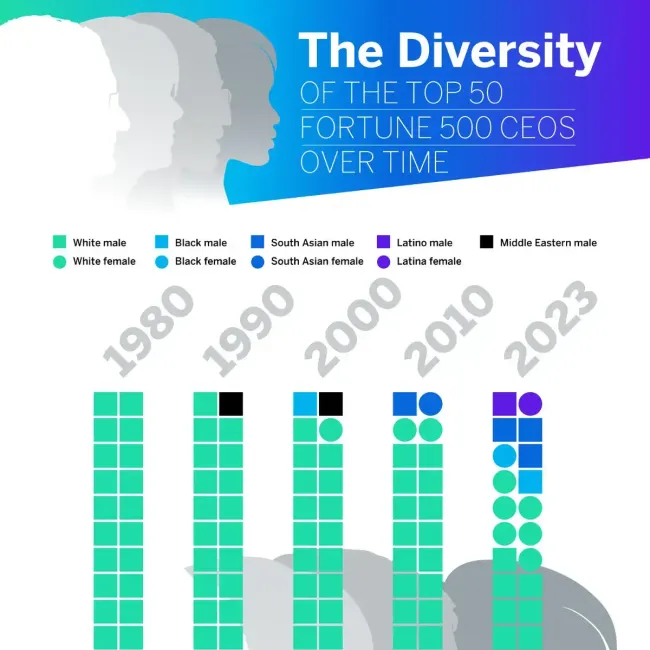Qualtrics is passionate about diversity, equity, and inclusion, and as part of this mission, we took a look at the top 50 CEOs of Fortune 500 companies to see how racially and gender diverse the leaders of America’s biggest companies have been through the decades.

Copy embed code below
<a href="https://www.qualtrics.com/articles/employee-experience/fortune-500-ceo-diversity/"><br /> <img src="https://www.qualtrics.com/sites/default/files/styles/standard_3xl/public/migrations/content/diversity-fortune-50-ceos-over-time-6_1200.png.webp" alt="The Diversity of the Top 50 Fortune 500 CEOs Over Time - Qualtrics.com - Infographic" title="The Diversity of the Top 50 Fortune 500 CEOs Over Time - Qualtrics.com - Infographic"><br /> </a><br /> <br><br /> <a href="https://www.qualtrics.com" alt="Qualtrics.com" title="Qualtrics.com">By Qualtrics.com</a>
How has the diversity of Fortune 500 companies changed over time?
Fortune 500 CEOs have overwhelmingly been white men, but in recent years, executive boards have been becoming more diverse. For instance, in 1980, all of the top 50 Fortune 500 companies’ CEOs were white men. In 2023, 37 of the top 50 companies’ CEOs were white men. In 2023, the CEOs of the top 50 Fortune 500 companies include six white women, one Hispanic/Latino man, one Hispanic/Latina woman, three South Asian men, one black man, and one black woman. Here are some diversity milestones of Fortune 500 CEOs:
- 1972: Katharine Graham became the first female CEO of a Fortune 500 company (The Washington Post).
- 1981: Roberto Goizueta became the first Hispanic/Latino man to become a Fortune 500 CEO (Coca-Cola).
- 1986: Gerald Tsai became the first East Asian male to become a Fortune 500 CEO (American Can Company).
- 1987: Clifton R. Wharton Jr., CEO of TIAA-CREF, became the first black male to be a Fortune 500 CEO (TIAA-CREF).
- 1997: Ramani Ayer was the first South Asian male to become a Fortune 500 CEO (The Hartford).
- 1999: Andrea Jung, the CEO of Avon, was the first East Asian Fortune 500 CEO (Avon).
- 2006: Indra Nooyi was the first South Asian Fortune 500 CEO (PepsiCo).
- 2009: Ursula M. Burns became the first black female CEO of a Fortune 500 company (Xerox).
- 2011: Tim Cook was the first LGBTQ+ CEO of a Fortune 500 company (Apple).
- 2017: Geisha Williams of PG&E became the first Hispanic/Latina female CEO of a Fortune 500 company (PG&E).
- 2018: Beth Ford was the first LGBTQ+ female to become the CEO of a Fortune 500 company (Land O’Lakes).
What percentage of Fortune 500 CEOs are female?
According to Fortune, in 2023, 10.4% of Fortune 500 CEOs were female. About a quarter of these female CEOs became CEOs of their respective companies within the past year. Some of the female CEOs on the Fortune 500 list include Karen Lynch (CVS Health), Mary Barra (General Motors), Priscilla Almodovar (Fannie Mae), and Gina R. Boswell (Bath & Body Works).
The history of the Fortune 500
The Fortune 500 is an annual list that is published by popular business magazine Fortune that ranks the largest corporations in the United States by revenue. It was officially created in 1955 by Fortune editor Edgar P. Smith. Originally, the list was comprised of companies based on revenue from manufacturing, energy exploration, and mining. The very first Fortune 500 company to top the list in 1955 was General Motors. Fortune also produces a Global 500 list, which is the annual ranking of the top 500 companies by revenue worldwide. In 2022, the top ten companies in the Global 500 were:
- Walmart (United States)
- Amazon (United States)
- State Grid (China)
- China National Petroleum (China)
- Sinopec Group (China)
- Saudi Aramco (Saudi Arabia)
- Apple (United States)
- Volkswagen (Germany)
- China State Construction Engineering (China)
- CVS Health (United States)
Related: XM for customer frontlines, XM for people teams, and XM for strategy and research.
The diversity of the top 50 companies in the Fortune 500
1980
- Exxon – Howard C. Kauffmann (Male, White)
- General Motors – Thomas Murphy (Male, White)
- Mobil – Rawleigh Warner Jr. (Male, White)
- Ford Motor – Philip Caldwell (Male, White)
- Texaco – John Key McKinley (Male, White)
- ChevronTexaco – Harold J. Haynes (Male, White)
- Gulf Oil – Jerry McAfee (Male, White)
- IBM – Frank T. Cary (Male, White)
- General Electric – Jack Welch (Male, White)
- Amoco – John E. Swearingen (Male, White)
- ITT Industries – Rand Araskog (Male, White)
- Atlantic Richfield – Robert Orville Anderson (Male, White)
- Shell Oil – John F. Bookout (Male, White)
- U.S. Steel – David M. Roderick (Male, White)
- Conoco – Ralph E. Bailey (Male, White)
- DuPont – Irving Saul Shapiro (Male, White)
- Chrysler – Lee Iacocca (Male, White)
- Tenneco Automotive – James L. Ketelsen (Male, White)
- AT&T Technologies – Charles L. Brown (Male, White)
- Sunoco – Theodore A. Burtis (Male, White)
- Occidental Petroleum – Armand Hammer (Male, White)
- ConocoPhillips – Ralph E. Bailey (Male, White)
- Procter & Gamble – Edward Harness (Male, White)
- Dow Chemical – Paul Oreffice (Male, White)
- Union Carbide – William S. Sneath (Male, White)
- United Technologies – Harry Gray (Male, White)
- International Harvester (Navistar International) – Archie R. McCardell (Male, White)
- Goodyear Tire & Rubber – Charles J. Pilliod Jr. (Male, White)
- Boeing – Thornton Wilson (Male, White)
- Eastman Kodak – Walter A. Fallon (Male, White)
- LTV – W. Paul Thayer (Male, White)
- Standard Oil (BP America) – John E. Swearingen (Male, White)
- Caterpillar – Bob Gilmore (Male, White)
- Unocal – Fred L. Hartley (Male, White)
- Beatrice – Wallace Rasmussen (Male, White)
- RCA – Edgar H. Griffiths (Male, White)
- CBS – Thomas H. Wyman (Male, White)
- Bethlehem Steel – Lewis W. Foy (Male, White)
- Nabisco Group Holdings – Robert M. Schaeberle (Male, White)
- Xerox – Charles Peter McColough (Male, White)
- Amerada Hess (Hess Corporation) – Leon Hess (Male, White)
- Esmark – Donald P. Kelly (Male, White)
- Marathon Oil – Harold D. Hoopman (Male, White)
- Ashland – Orin E. Atkins (Male, White)
- Rockwell Automation – Robert Anderson (Male, White)
- Kraft – John Marshall Richman (Male, White)
- Cities Service Company (Citgo Petroleum) – Robert V. Sellers (Male, White)
- Monsanto – Jack Hanley (Male, White)
- Philip Morris (Altria Group) – Frank E. Resnik (Male, White)
- General Foods – James L. Ferguson (Male, White)
1990
- Ford Motor – Harold Arthur Poling (Male, White)
- Exxon Mobil – Lawrence G. Rawl (Male, White)
- IBM – John Fellows Akers (Male, White)
- General Electric – John Francis Welch Jr. (Male, White)
- Mobil – Allen E. Murray (Male, White)
- Altria Group (Philip Morris) – Hamish Maxwell (Male, White)
- Chrysler – Lee Iacocca (Male, White)
- DuPont – Edgar S. Woolard Jr. (Male, White)
- Texaco – Alfred C. DeCrane Jr. (Male, White)
- Chevron – Kenneth T. Derr (Male, White)
- Amoco – H. Laurance Fuller (Male, White)
- Shell Oil – Frank H. Richardson (Male, White)
- Procter & Gamble – Edwin L. Artzt (Male, White)
- Boeing – Frank Shrontz (Male, White)
- Occidental Petroleum – Ray R. Irani (Male, Middle Eastern)
- United Technologies – Robert F. Daniell (Male, White)
- Eastman Kodak – Kay Whitmore (Male, White)
- Marathon Oil (U.S. Steel) – Charles Corry (Male, White)
- Dow Chemical – Frank Popoff (Male, White)
- Xerox – Paul Allaire (Male, White)
- Atlantic Richfield – Lodwrick Cook (Male, White)
- PepsiCo – Wayne Calloway (Male, White)
- Nabisco Group Holdings – F. Ross Johnson (Male, White)
- McDonnell Douglas – John F. McDonnell (Male, White)
- Tenneco Automotive – James L. Ketelsen (Male, White)
- Digital Equipment – Ken Olsen (Male, White)
- CBS – Laurence Tisch (Male, White)
- Rockwell Automation – Donald R. Beall (Male, White)
- Conoco (ConocoPhillips) – Ralph E. Bailey (Male, White)
- Honeywell – James Renier (Male, White)
- 3M – Allen F. Jacobson (Male, White)
- Hewlett-Packard – John A. Young (Male, White)
- Sara Lee – John H. Bryan (Male, White)
- International Paper – John Georges (Male, White)
- ConAgra Foods – C. Michael Harper (Male, White)
- Alcoa – Paul H. O'Neill (Male, White)
- Caterpillar – Donald V. Fites (Male, White)
- Goodyear Tire & Rubber – Tom H. Barrett (Male, White)
- Unocal – Richard Stegemeier (Male, White)
- Georgia-Pacific – T. Marshall Hahn (Male, White)
- Weyerhaeuser – George H. Weyerhaeuser Sr. (Male, White)
- Unisys – James Unruh (Male, White)
- General Dynamics – Herbert F. Rogers (Male, White)
- Martin Marietta (Lockheed Martin) – Norman R. Augustine (Male, White)
- Sun Company (Sunoco) – Robert McClements Jr. (Male, White)
- Johnson & Johnson – Ralph S. Larsen (Male, White)
- Motorola – George M.C. Fisher (Male, White)
- Anheuser-Busch – August Busch III (Male, White)
- Bristol-Myers Squibb – Richard L. Gelb (Male, White)
Note: One name has been omitted from this ranking at the request of the party involved.
2000
- Wal-Mart Stores – Lee Scott (Male, White)
- Exxon Mobil – Lee Roy Raymond (Male, White)
- Ford Motor – Jacques Albert Nasser (Male, Middle Eastern)
- General Electric – John Francis Welch Jr. (Male, White)
- IBM – Louis Vincent Gerstner Jr. (Male, White)
- Citigroup – Sanford I. Weill (Male, White)
- AT&T – Edward Whitacre Jr. (Male, White)
- Altria Group (Philip Morris) – Geoffrey C. Bible (Male, White)
- Boeing – Harry Stonecipher (Male, White)
- Bank of America Corp. – Hugh McColl (Male, White)
- SBC Communications – Edward Whitacre Jr. (Male, White)
- Hewlett-Packard – Carly Fiorina (Female, White)
- Kroger – Joseph A. Pichler (Male, White)
- State Farm Insurance Cos. – Edward B. Rust Jr. (Male, White)
- Sears Roebuck – Arthur C. Martinez (Male, White)
- American Intl. Group – Maurice R. Greenberg (Male, White)
- Enron – Kenneth Lay (Male, White)
- TIAA-CREF – John Biggs (Male, White)
- Compaq Computer – Michael Capellas (Male, White)
- Home Depot – Robert Nardelli (Male, White)
- Lucent Technologies – Rich McGinn (Male, White)
- Procter & Gamble – Durk Jager (Male, White)
- Albertson's – Gary G. Michael (Male, White)
- MCI WorldCom – Bernard Ebbers (Male, White)
- Fannie Mae – Franklin Raines (Male, Black)
- Kmart Holding – Charles Conaway (Male, White)
- Texaco – Peter Bijur (Male, White)
- Merrill Lynch – David Komansky (Male, White)
- Morgan Stanley – Philip J. Purcell (Male, White)
- Chase Manhattan Corp. – William B. Harrison Jr. (Male, White)
- Target – Bob Ulrich (Male, White)
- Bell Atlantic (Verizon Communications) – Ivan Seidenberg (Male, White)
- Merck – Raymond Gilmartin (Male, White)
- ChevronTexaco – Dave O'Reilly (Male, White)
- J.C. Penney – Allen Questrom (Male, White)
- Motorola – Christopher Galvin (Male, White)
- McKesson – John Hammergren (Male, White)
- Intel – Craig Barrett (Male, White)
- Safeway – Steven Burd (Male, White)
- Ingram Micro – Kent B. Foster (Male, White)
- DuPont – Charles O. Holliday (Male, White)
- Johnson & Johnson – Ralph S. Larsen (Male, White)
- Costco Wholesale – James Sinegal (Male, White)
- Time Warner – Gerald M. Levin (Male, White)
- UPS – Jim Kelly (Male, White)
- Allstate – Ed Liddy (Male, White)
- Prudential Financial – Arthur F. Ryan (Male, White)
- Aetna – John Rowe (Male, White)
- Bank One Corp. – Jamie Dimon (Male, White)
Note: One name has been omitted from this ranking at the request of the party involved.
2010
- Wal-Mart Stores – William S. Simon (Male, White)
- Exxon Mobil – Rex Tillerson (Male, White)
- Chevron – John S. Watson (Male, White)
- General Electric – Jeffrey Robert Immelt (Male, White)
- Bank of America Corp. – Brian Thomas Moynihan (Male, White)
- ConocoPhillips – James Mulva (Male, White)
- AT&T – Randall Lynn Stephenson (Male, White)
- Ford Motor – Alan Mulally (Male, White)
- J.P. Morgan Chase & Co. – Jamie Dimon (Male, White)
- Hewlett-Packard – Mark Hurd (Male, White)
- Berkshire Hathaway – Warren Buffett (Male, White)
- Citigroup – Vikram Shankar Pandit (Male, South Asian)
- Verizon Communications – Ivan Seidenberg (Male, White)
- McKesson – John Hammergren (Male, White)
- General Motors – Edward Whitacre Jr. (Male, White)
- AIG – Bob Benmosche (Male, White)
- Cardinal Health – George S. Barrett (Male, White)
- CVS Caremark – Thomas Ryan (Male, White)
- Wells Fargo – John Stumpf (Male, White)
- IBM – Samuel J. Palmisano (Male, White)
- UnitedHealth Group – Stephen Hemsley (Male, White)
- Procter & Gamble – A.G. Lafley (Male, White)
- Kroger – David Dillon (Male, White)
- AmerisourceBergen – R. David Yost (Male, White)
- Costco Wholesale – James Sinegal (Male, White)
- Valero Energy – William R. Klesse (Male, White)
- Archer Daniels Midland – Patricia A. Woertz (Female, White)
- Boeing – James McNerney (Male, White)
- Home Depot – Frank Blake (Male, White)
- Target – Gregg Steinhafel (Male, White)
- WellPoint (Elevance Health) – Angela Braly (Female, White)
- Walgreens – Greg Wasson (Male, White)
- Johnson & Johnson – William C. Weldon (Male, White)
- State Farm Insurance Cos. – Edward B. Rust Jr. (Male, White)
- Medco Health Solutions – David B. Snow Jr. (Male, White)
- Microsoft – Steve Ballmer (Male, White)
- United Technologies – Louis R. Chênevert (Male, White)
- Dell – Michael Dell (Male, White)
- Goldman Sachs Group – Lloyd Blankfein (Male, White)
- Pfizer – Jeff Kindler (Male, White)
- Marathon Oil – Clarence P. Cazalot Jr. (Male, White)
- Lowe's – Robert Niblock (Male, White)
- UPS – Scott Davis (Male, White)
- Lockheed Martin – Robert J. Stevens (Male, White)
- Best Buy – Brian J. Dunn (Male, White)
- Dow Chemical – Andrew Liveris (Male, White)
- Supervalu – Craig Herkert (Male, White)
- Sears Holdings – W. Bruce Johnson (Male, White)
- International Assets Holding (StoneX Group Inc.) – Sean O'Connor (Male, White)
- PepsiCo – Indra Nooyi (Female, South Asian)
2023
- Walmart – Douglas McMillon (Male, White)
- Amazon.com – Andrew R. Jassy (Male, White)
- Exxon Mobil – Darren W. Woods (Male, White)
- Apple – Timothy D. Cook (Male, White)
- UnitedHealth Group – Andrew P. Witty (Male, White)
- CVS Health – Karen S. Lynch (Female, White)
- Berkshire Hathaway – Warren E. Buffett (Male, White)
- Alphabet – Sundar Pichai (Male, South Asian)
- McKesson – Brian S. Tyler (Male, White)
- Chevron – Michael K. Wirth (Male, White)
- AmerisourceBergen – Steven H. Collis (Male, White)
- Costco Wholesale – Craig Jelinek (Male, White)
- Microsoft – Satya Nadella (Male, South Asian)
- Cardinal Health – Jason Hollar (Male, White)
- Cigna Group – David M. Cordani (Male, White)
- Marathon Petroleum – Michael J. Hennigan (Male, White)
- Phillips 66 – Mark Lashier (Male, White)
- Valero Energy – Joseph W. Gorder (Male, White)
- Ford Motor – Jim Farley (Male, White)
- Home Depot – Ted Decker (Male, White)
- General Motors – Mary T. Barra (Female, White)
- Elevance Health – Gail K. Boudreaux (Female, White)
- JPMorgan Chase – Jamie Dimon (Male, White)
- Kroger – Rodney McMullen (Male, White)
- Centene – Sarah M. London (Female, White)
- Verizon Communications – Hans E. Vestberg (Male, White)
- Walgreens Boots Alliance – Roz Brewer (Female, Black)
- Fannie Mae – Priscilla Almodovar (Female, Hispanic/Latina)
- Comcast – Brian L. Roberts (Male, White)
- AT&T – John T. Stankey (Male, White)
- Meta Platforms – Mark Zuckerberg (Male, White)
- Bank of America – Brian Moynihan (Male, White)
- Target – Brian C. Cornell (Male, White)
- Dell Technologies – Michael S. Dell (Male, White)
- Archer Daniels Midland – Juan R. Luciano (Male, Hispanic/Latino)
- Citigroup – Jane Fraser (Female, White)
- UPS – Carol B. Tome (Female, White)
- Pfizer – Albert Bourla (Male, White)
- Lowe's – Marvin R. Ellison (Male, Black)
- Johnson & Johnson – Joaquin Duato (Male, White)
- FedEx – Raj Subramaniam (Male, South Asian)
- Humana – Bruce D. Broussard (Male, White)
- Energy Transfer – Thomas E. Long (Male, White)
- State Farm Insurance – Michael L. Tipsord (Male, White)
- Freddie Mac – Michael Devito (Male, White)
- PepsiCo – Ramon L. Laguarta (Male, White)
- Wells Fargo – Charles W. Scharf (Male, White)
- Walt Disney – Robert A. Chapek (Male, White)
- ConocoPhillips – Ryan M. Lance (Male, White)
- Tesla – Elon Musk (Male, White)
Fortune 500 CEO Firsts
- First Female – Katharine Graham, The Washington Post (1972)
- First Hispanic/Latino Male – Roberto Goizueta, Coca-Cola (1981)
- First East Asian Male – Gerald Tsai, The American Can Company (1986)
- First Black Male – Clifton R. Wharton, Jr., TIAA-CREF (1987)
- First South Asian Male – Ramani Ayer, The Hartford (1997)
- First East Asian Female – Andrea Jung, Avon (1999)
- First South Asian Female – Indra Nooyi, PepsiCo (2006)
- First Black Female – Ursula M. Burns, Xerox (2009)
- First Openly LGBTQ+ Male – Tim Cook, Apple (2011)
- First Hispanic/Latina Female – Geisha Williams, PG&E (2017)
- First Openly LGBTQ+ Female – Beth Ford, Land O'Lakes (2018)



